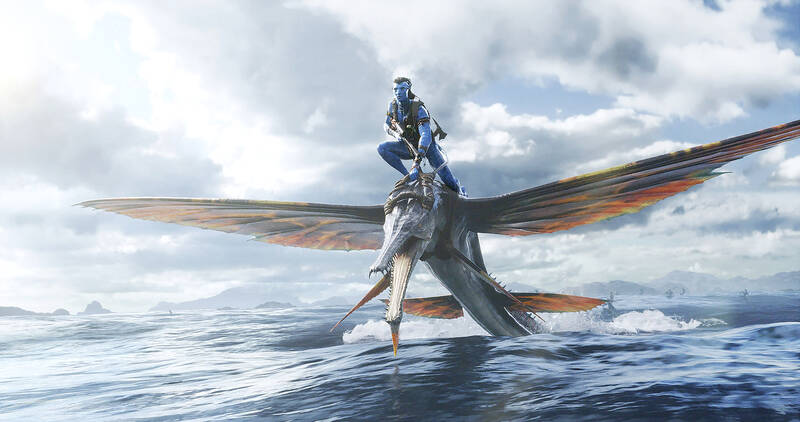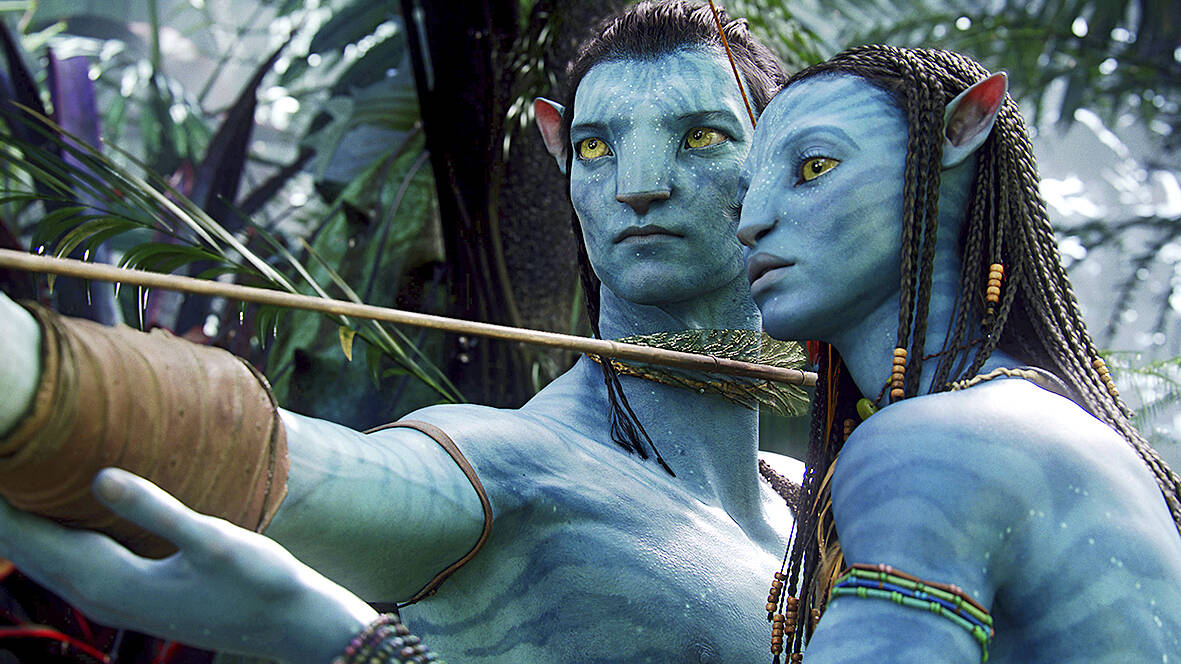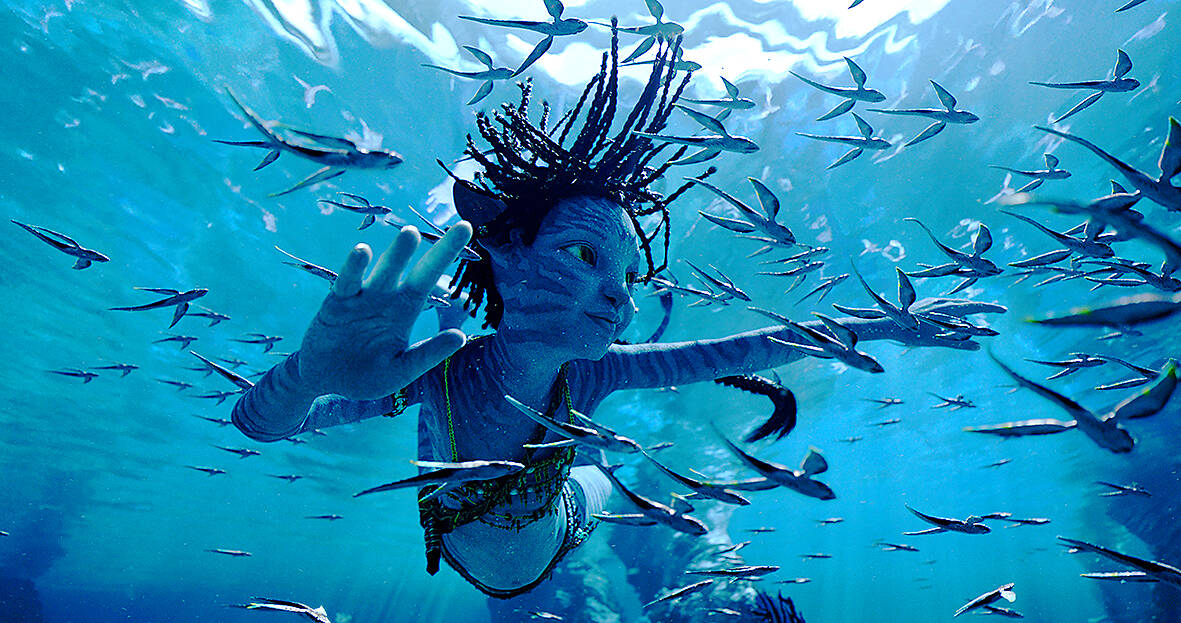It is impossible to talk about Avatar: The Way of Water without sounding hyperbolic. But James Cameron’s sequel is a truly dazzling cinematic experience that will have you floating on a blockbuster high.
No matter if you’ve spent a second of your life in the past 13 years thinking about what’s happening on Pandora or how Jake Sully (Sam Worthington) and Neytiri (Zoe Saldana) are getting on, assuming you remember their characters’ names. The Way of Water will make awe-struck believers out of even Avatar agnostics like me, at least for three hours and 12 minutes. The film, which is currently playing in Taiwan’s theaters, isn’t just visually compelling, either, it’s spiritually rich as well — a simple but penetrating story about family and the natural world that is galaxies better than the first.
About that run time: Three hours and 12 minutes sounds excessive, but there is something decidedly decadent about really committing that much time to a movie in a theater. When the filmmaker is purposeful with that time, as Cameron is and many others have been before him, it’s a uniquely rewarding experience. In other words, it’s not a big ask. And you’ll forget all about checking the time from the first shot of Pandora and Jake’s earnest exposition about what’s been going on in the past decade.

Photo: AP
He and Neytiri have three kids now, Neteyam (Jamie Flatters), Lo’ak (Britain Dalton), Tuk (Trinity Jo-Li Bliss) and an adopted teenage daughter, Kiri (Sigourney Weaver), and they’re happy living in the forest.
“Happiness is simple,” he says. “Who ever thought that a jughead like me could crack the code?”
So, of course, it can’t last. The humans are on the hunt for Jake, with a familiar antagonist leading the charge. And soon his family is on the run, taking up home in another part of Pandora, on the water with a new tribe led by Ronal (Kate Winslet) and Tonowari (Cliff Curtis) who reluctantly grant them refuge and try to teach them how to live on the water.

Photo: AP
It’s worth noting that Cameron has not stuffed the film with mind-numbing, wall-to-wall action and needlessly complicated plot. There are long stretches of movie where we’re simply exploring the environment with the characters, delighting in the intricacies of a reef or basking in the beauty of giant sea creatures.
Sometimes we’re just sitting in the water with Kiri who is also sitting in the water. It is not advancing the action in any obvious way. It is not even really developing characters. It just is, and it’s serene. You imagine that anyone without his clout would have a hard time justifying something similar.
The action is there, too, of course, and it’s exciting because you’ve become invested in the family and worried about the kids who are never where they’re supposed to be and are often in danger because of it. And though we know there are more sequels coming, and one already wrapped, this is not the kind of franchise where anyone is guaranteed to get a fake superhero death.

Photo: AP
Sure there is some Avatar silliness, including the fact that the word “bro” is uttered about 8,000 times, but there is something admirable about the straightforward dialogue and emotions at play, too. No one is snarking their way through this ordeal.
“Never doubt James Cameron” has become a bit of a rallying cry lately, at least among those left on Twitter. It’s all the more extraordinary as the once-mythical sequels had become a kind of joke in the years since the first movie. Even as The Way of Water release date actually approached the “who cares?” chorus intensified. Had anyone really thought twice about Avatar? But Cameron knows his way around a thrilling sequel, and the water for that matter (and references his own greatest hits in this film, too).
But then people saw it and the tune changed. There is something comforting about the fact that we are capable of intense, collective cultural whiplash. That “who cares?” can turn to uncynical amazement in an instant. Is that the magic of the movies? Of continuing to push the bounds of the big screen experience? Of betting big on weird-sounding stories about giant blue environmentalists instead of superheroes every so often? Maybe it’s just the magic of James Cameron.

Photo: AP

Aug. 4 to Aug. 10 When Coca-Cola finally pushed its way into Taiwan’s market in 1968, it allegedly vowed to wipe out its major domestic rival Hey Song within five years. But Hey Song, which began as a manual operation in a family cow shed in 1925, had proven its resilience, surviving numerous setbacks — including the loss of autonomy and nearly all its assets due to the Japanese colonial government’s wartime economic policy. By the 1960s, Hey Song had risen to the top of Taiwan’s beverage industry. This success was driven not only by president Chang Wen-chi’s

Last week, on the heels of the recall election that turned out so badly for Taiwan, came the news that US President Donald Trump had blocked the transit of President William Lai (賴清德) through the US on his way to Latin America. A few days later the international media reported that in June a scheduled visit by Minister of National Defense Wellington Koo (顧立雄) for high level meetings was canceled by the US after China’s President Xi Jinping (習近平) asked Trump to curb US engagement with Taiwan during a June phone call. The cancellation of Lai’s transit was a gaudy

From Godzilla’s fiery atomic breath to post-apocalyptic anime and harrowing depictions of radiation sickness, the influence of the nuclear bombings of Hiroshima and Nagasaki runs deep in Japanese popular culture. In the 80 years since the World War II attacks, stories of destruction and mutation have been fused with fears around natural disasters and, more recently, the Fukushima crisis. Classic manga and anime series Astro Boy is called “Mighty Atom” in Japanese, while city-leveling explosions loom large in other titles such as Akira, Neon Genesis Evangelion and Attack on Titan. “Living through tremendous pain” and overcoming trauma is a recurrent theme in Japan’s

As last month dawned, the Democratic Progressive Party (DPP) was in a good position. The recall campaigns had strong momentum, polling showed many Chinese Nationalist Party (KMT) lawmakers at risk of recall and even the KMT was bracing for losing seats while facing a tsunami of voter fraud investigations. Polling pointed to some of the recalls being a lock for victory. Though in most districts the majority was against recalling their lawmaker, among voters “definitely” planning to vote, there were double-digit margins in favor of recall in at least five districts, with three districts near or above 20 percent in